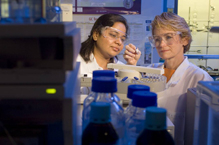Mazurek is conducting research on air quality and working towards worldwide sensor coverage

As an experienced researcher in air quality, Monica Mazurek knows firsthand that air pollution respects no state or national boundaries. Three years ago, she measured how forest fires raging in western Canada were causing New York’s air quality levels to soar beyond acceptable limits. Her current studies of New York metropolitan air quality involve analyzing particulates collected across the tri-state region. And going forward, she hopes to participate in a study of chemical aerosols originating in China and drifting across India toward the Indian Ocean.
So it’s not surprising that Mazurek, an assistant professor of civil and environmental engineering in New Brunswick, champions a global response to these problems. Over the past six months, Mazurek hosted a national laboratory researcher from the Indian Institute of Chemical Technology in Hyderabad, mentoring her in the scope of setting up a regional network of air quality chemical sensors and the fine points of running it. And now that the researcher, Monika Kulshrestha, has returned to India, Mazurek is getting ready to welcome Zhiqiang Sun, director of the City of Shijiazhuang Air Monitoring Center and Bureau of Environmental Protection in Shijiazhuang, China.
“It’s important to train scientists around the world to monitor air quality,” Mazurek said, noting that funding in many countries is spotty or occasional. “We’re dealing with a global problem, and we need governments willing to support the study and control of air pollution.”
Mazurek would like to see a network of air quality monitoring stations all around the world, connected through an international consortium of air quality scientists and managers, as comprehensive as the network now covering the New York metropolitan area. She is working on an inventory of organic pollutants – carbon-based molecules and particulates resulting from burning coal, oil and wood, and even from frying foods – at six of these sites, from Chester, New Jersey, to Westport, Connecticut. She looks for molecules that are specific to petroleum, vegetation, and cooking oils, and, after determining their proportions in the pollution mix, recommends which sources of pollution the states should focus their resources toward controlling.
“The technology is here to support international collaborations that measure key gas and particle phase pollutants and share that data among scientists, air quality managers, and policymakers worldwide,” said Mazurek. “Such partnerships would be an essential first step toward reducing emissions to regional, international and global airsheds.”
By hosting Kulshrestha, Mazurek took a step toward her goal of worldwide sensor coverage. Kulshrestha now plans to seek funding to design and implement sensor networks, while Mazurek initiates a National Science Foundation proposal to fund an international cooperative agreement between the United States and Indian governments.
While at Rutgers, Kulshrestha worked with research associate Min Li to master the detail work of sampling and analysis for air pollution – steps that need to be followed stringently to ensure the accuracy of the data. These include knowing how much of a sample to collect, analyzing samples using sophisticated instruments such as mass spectrometers, and, most important, avoiding contamination.
“In my first weeks [at Rutgers], I was already sharing the knowledge I gained with my colleagues back in India, such as how to bake filters to remove traces of organic contaminants,” Kulshrestha said. And during her final weeks at Rutgers, she and Li analyzed airborne particles that her colleagues collected in June in Hyderabad. “We are excited about the abundance of markers we saw in these samples. This should help us understand the sources of emissions in the region.”
Kulshrestha felt privileged to work with one of the top researchers in this field. “My training will help me conduct world-class research at home and address the air pollution problems in South Asia.” She was funded by an Indian Department of Science and Technology fellowship known as BOYSCAST, or “Better Opportunities for Young Acientists in Chosen Areas of Science and Technology.” It supports young Indian scientists and engineers working in emerging and challenging fields to enhance their skills through international collaboration.